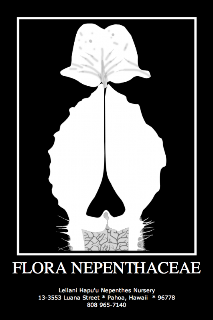|
|
Post by unclemasa on Jan 27, 2008 23:31:51 GMT -10
N. thorelii Lecomte (1909)
Indochina; Moss Forest, Sand Fields
Cultivars: 'Aglow Koto' 'Felicitous Koto'
Stems: climbing; narrow.
Leaves: sessile, decurrent; lamina linear- lanceolate.
Lower Pitchers: ventricose in the lower part, tubulose in the upper part, but contracted from the middle to the mouth; 2 fimbriate wings present; mouth oblique, elevated to neck; peristome cylindrical to flattened; lid ovate, apex acute, base attenuate, slightly vaulted.
Upper Pitchers: infundibulate in the lower part, then slightly ventricose, then tubular in the upper part; 2 prominent ribs present; mouth oblique, elevated to neck; peristome cylindrical to flattened; lid orbicular- ovate, apex acute, base attenuate, lid slightly vaulted.
Inflorescence: a raceme.
Indumentum:not present.
Color: tendril reddish- yellow, pitchers green to reddish, peristome red.
Distinguishing Features:
|
|
|
|
Post by sockhom on May 6, 2008 11:16:06 GMT -10
The description below is the description of N. thorelii made by the french botanist Henri Lecomte. It was published in Notulae Systematicae in 1909. I have made the translation from the french of the text which is under the latin diagnosis. François Mey. " Nepenthes thorelii H. Lec. Planta paludosa in silvestris. Caulis tere, 6-12 decim. altus, 5-6 mm crassus, glaber. Folia 12-20 cm. longa, submembranacea, sessilia vel subpetiolata, semi-amplexicaulia, ad 5-15 mm. , decurrentia, petiolis alatis, lanceolata, apice acuta, in cirrum attenuata, glabra; nervi longitudinales in paria 3-4 dispositi, obscuri, omnes e basi folii v. Par intimum e triente inferioris costae oriundi, par intimum 7 mm. , par secundum 9 mm. , par exterius 10-10,5 mm. a costa remotum; nervi transversi valde obscuri, oblique ascendentes; cirrus 7-15 cm. longus, versus basin ascidii leviter ampliatus, glaber. Ascidia 5-7 cm. longa, 2,5-4 cm. lata, juventute ferrugineo-pubescentia, demum glabra, valde reticulato-nervosa, dimorpha ; inferiora cylindrica, minima, gradatim in cirrum attenuata ; superiora ampulliforma ; alae ventrales ciliatae ; peristomium cylindricum, 4-6mm. latum, in collum valde elongatum, apud ascidia inferiora minimum, crebre striatum ; operculum 1,8-3,5 cm. diametro, emarginatum, cordato-orbiculare, extus +- pubescens, intus glandulis multis immersis, perithecioideis, dispersis obsitum ; calcar 3-4 mm. longum vel nullum ;ascidium intusad trientem v. dimidium superius opacum, breve angustatum, inferne nitidum, glandulosum, et longe attneuatum ; glandulae profonde immersae. Inflorescentia male : 12-15 cm. longa, ferrugineo-villosa ; peduncullus villosi. Flores 7-8 mm. diametro. Sepala ovalia extus et ad marginem intus tomentosa, intus glandulis multis parvis obsita. Columna staminea sepala aequans, basi villosa. Pedunculus usque 60 cm. longus ; racemus laxiflorus. Ovarium dense sericeo-pubescens, quadratum ; stigma sessile, 4-lobum, medio depressum. Capsula 1-5 cm. longa, sparse albido vel brunneo-pubercula, demum brunneo-nitida, lobis stigmaticis triangulis depressis. Semina 4,5 mm. longa. This species is close to N. vieillardii Hook. f. ; it can be distinguished from the latter by the leaves venation which is clearly less pronounced, by the less abundant inflorescences, by the male and female inflorescence peduncula which are much longer, by the stamina column which is hairy in its lower third. It has been collected by Doctor Thorel in Ti-Tinh (Cochinchine) n°1032, where it can be found in the forest marshes, on slopes or amidst other grasses; it flowers in june.
"In the morning, said Doctor Thorel, the pitcher is filled with limpid water; then the liD closes; it is in the evening only that it sets upright almost vertically.”
Cochinchine: (Germain) (Dr Harmand and Godefroy) ; Ha-tien (Pierre); Guia-Toan; Lo-thieu; marshes of the surroundings of Ti-Tinh, n°1032 (Dr Thorel).
Cambodia: ad montem pursat, n°344 (Godefroy)." This is the material mentioned above, n°1032: www.lhnn.proboards107.com/index.cgi?board=herbarium&action=display&thread=864 |
|




